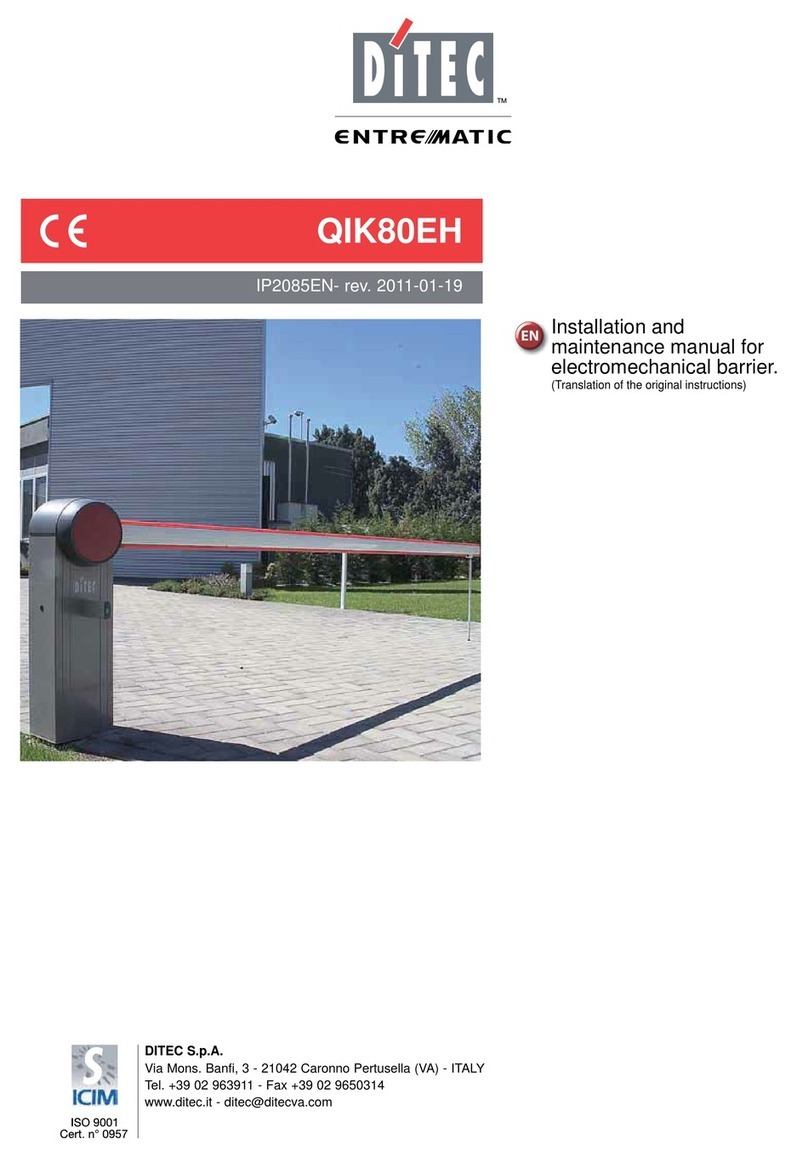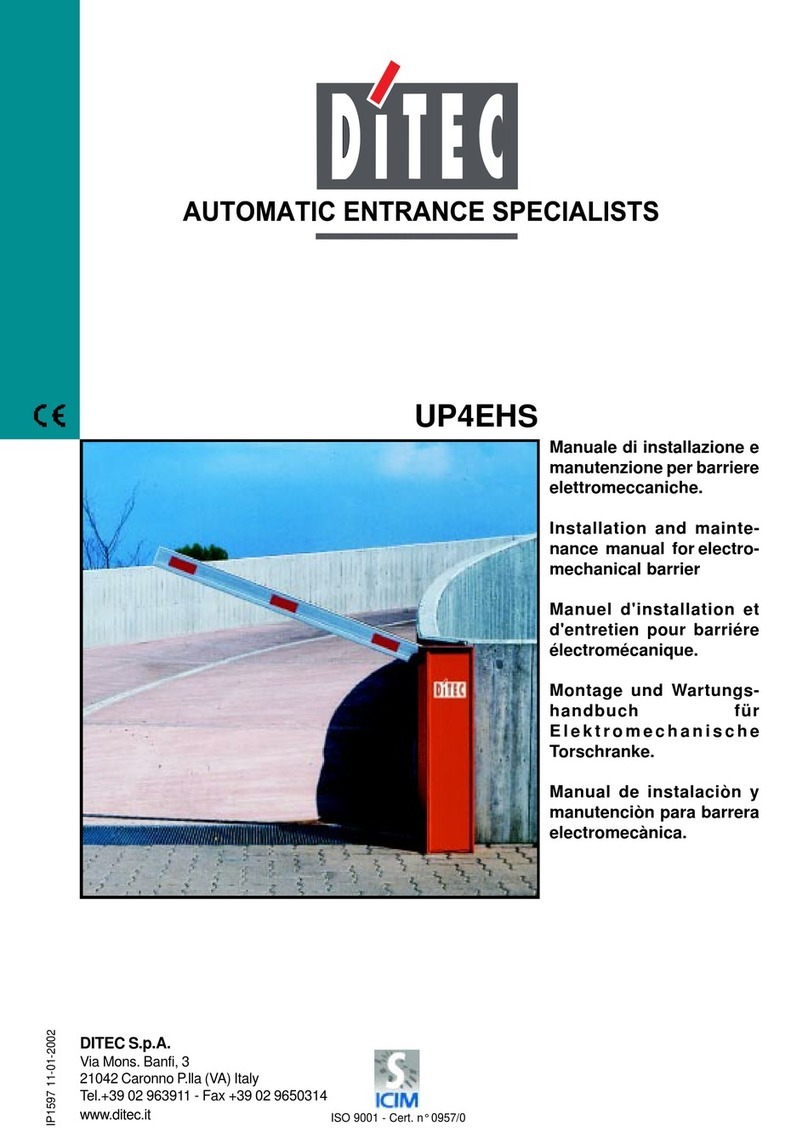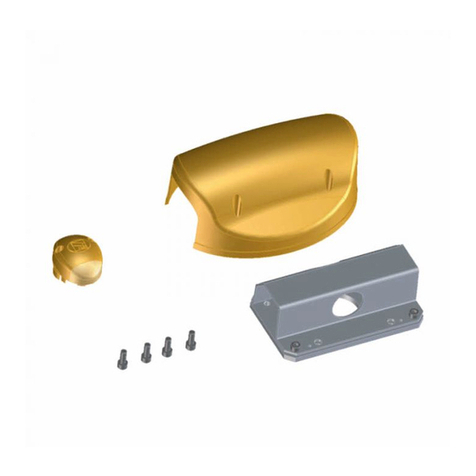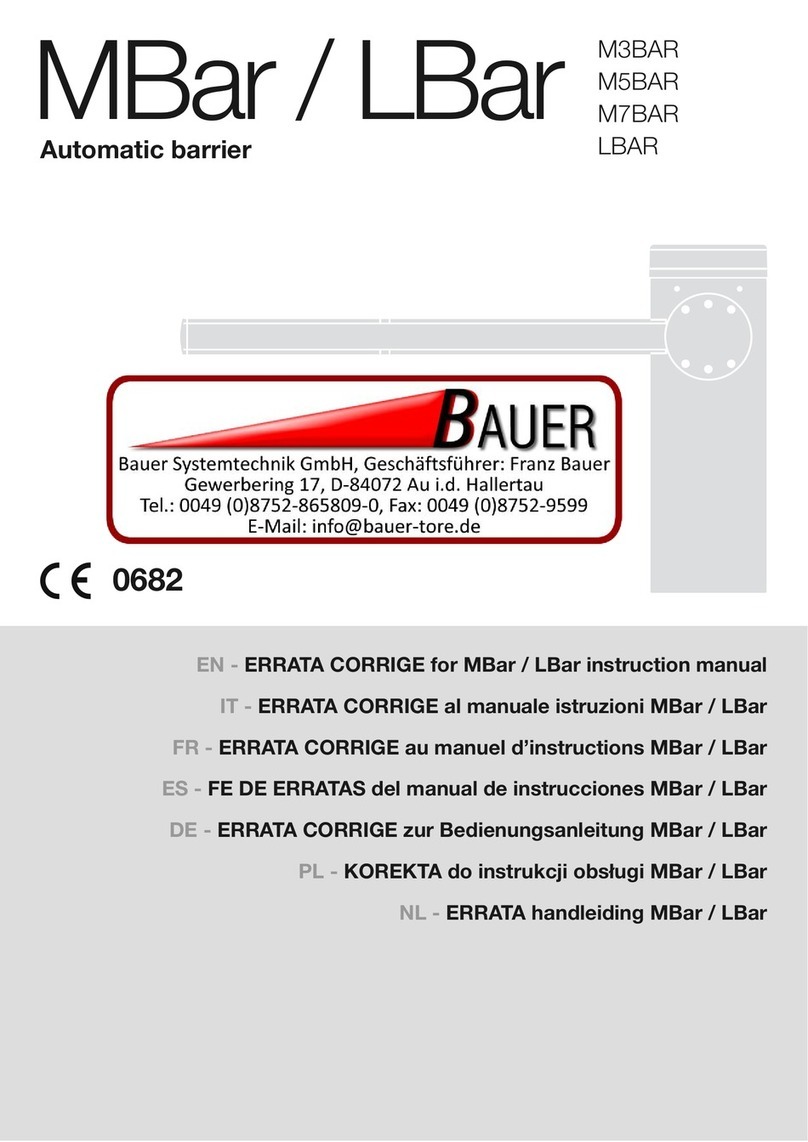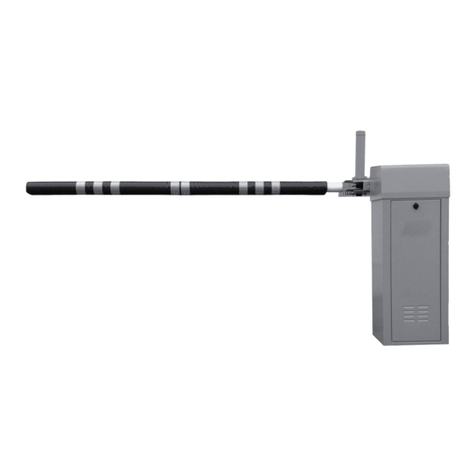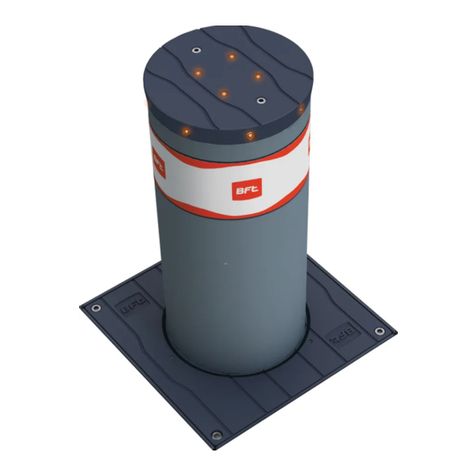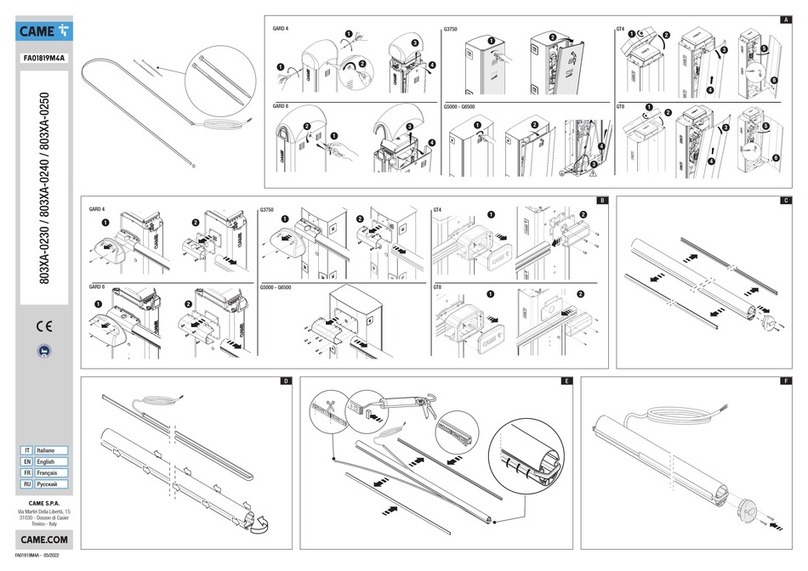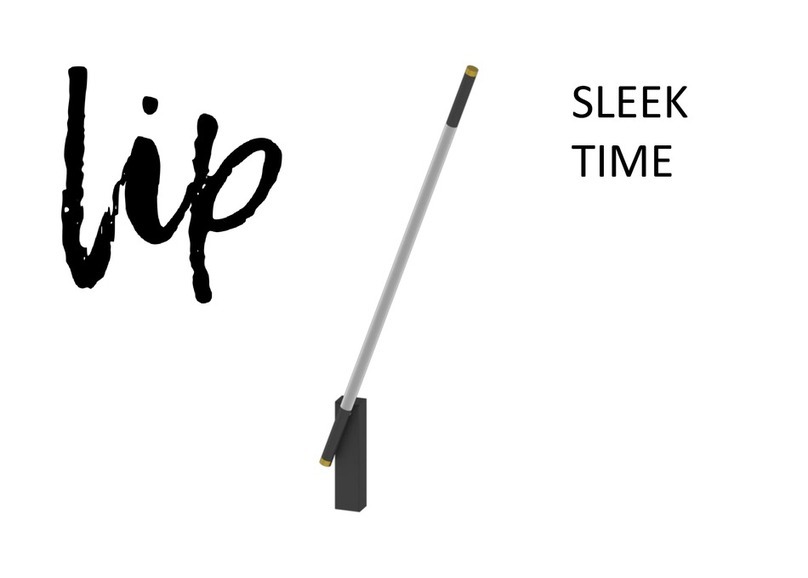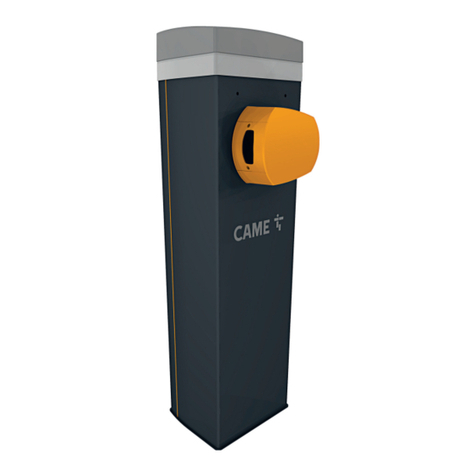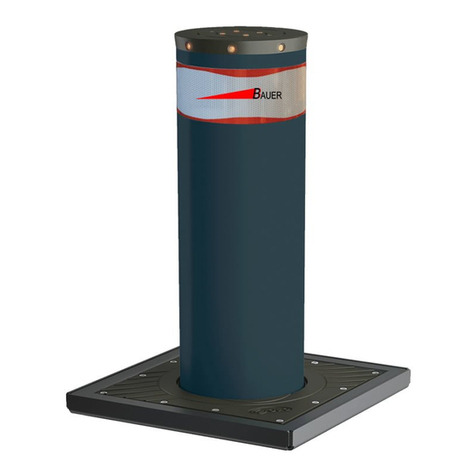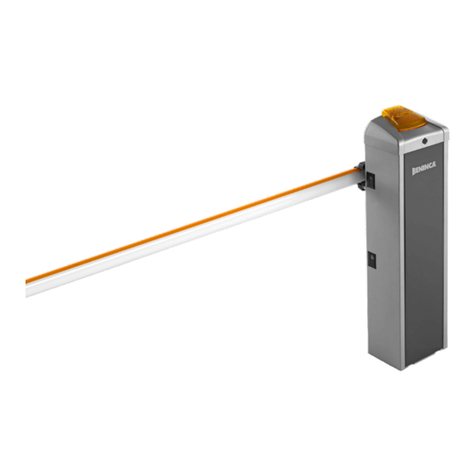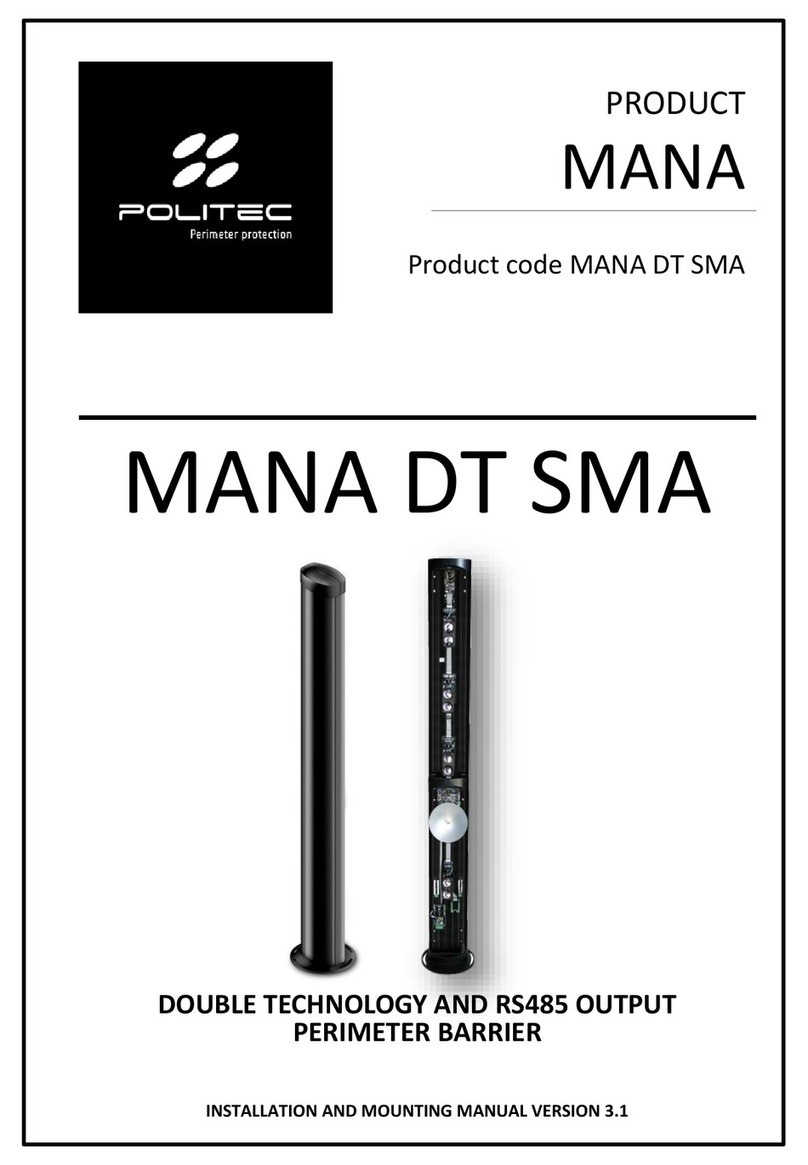DITEC UP8 Series Manual

DITEC S.p.A.
Via Mons. Banfi , 3 - 21042 Caronno Pertusella (VA) - ITALY
Tel. +39 02 963911 - Fax +39 02 9650314
www.ditec.it - [email protected]
Manuale di installazione
e manutenzione per bar-
riere elettromeccaniche
Installation and mainte-
nance manual for electro-
mechanical barrier
Manuel d’installation et
d’entretien pour barriére
électromécanique
Montage und Wartung-
shandbuch für Elektro-
mechanische Torschranke
Manual de instalaciòn y
manutenciòn para barrera
electromecànica
Manual de instalação e
Manutenção
para barreiras
electromecânicas
UP8
IP1782 - rev. 2005-05-05
I
GB
F
D
E
P

2
UP8 - IP1782
TX - 4x0.5 mm²
RX - 4x0.5 mm²
RX - 4x0.5 mm²
3x1.5 mm²
1
6
3
6
2
6
5
2x1.5 mm²
TX - 4x0.5 mm²
4x0.5 mm²
4
UP AF
450 380
260
1000
900
17
16
19
9
7
14
18
10
12
8
13
15
11
10 350
450
160
260
Fig. 1
Fig. 2
Fig. 3

3
UP8 - IP1782
19
12
18
20
Fig. 6
Fig. 7
Fig. 8
Fig. 4
DIP2=OFF
DIP2=ON
17
14
18
17
15
NOT USE
*
*
16
*
90°
1
3
2
Fig. 5

4
UP
8
- IP1
78
2
I
AVVERTENZE GENERALI PER LA SICUREZZA
Il presente manuale di installazione è rivolto esclusivamen-
te a personale professionalmente competente.
L’installazione, i collegamenti elettrici e le regolazioni
devono essere effettuati nell’osservanza della Buona Tecnica
e in ottemperanza alle norme vigenti.
Leggere attentamente le istruzioni prima di iniziare l’installazione
del prodotto. Una errata installazione può essere fonte di peri-
colo. I materiali dell’imballaggio (plastica, polistirolo, ecc.) non
vanno dispersi nell’ambiente e non devono essere lasciati alla
portata dei bambini in quanto potenziali fonti di pericolo.
Prima di iniziare l’installazione verifi care l’integrità del prodotto.
Non installare il prodotto in ambiente e atmosfera esplosivi: pre-
senza di gas o fumi infi ammabili costituiscono un grave pericolo
per la sicurezza. Prima di installare la motorizzazione, apportare
tutte le modifi che strutturali relative alla realizzazione dei franchi
di sicurezza ed alla protezione o segregazione di tutte le zone
di schiacciamento, cesoiamento, convogliamento e di pericolo
in genere. Verifi care che la struttura esistente abbia i necessari
requisiti di robustezza e stabilità. Il costruttore della motorizza-
zione non è responsabile dell’inosservanza della Buona Tecnica
nella costruzione degli infi ssi da motorizzare, nonché delle de-
formazioni che dovessero intervenire nell’utilizzo. I dispositivi di
sicurezza (fotocellule, coste sensibili, stop di emergenza, ecc.)
devono essere installati tenendo in considerazione: le normative
e le direttive in vigore, i criteri della Buona Tecnica, l’ambiente
di installazione, la logica di funzionamento del sistema e le for-
ze sviluppate dalla porta o cancello motorizzati. I dispositivi di
sicurezza devono proteggere eventuali zone di schiacciamento,
cesoiamento, convogliamento e di pericolo in genere, della porta
o cancello motorizzati.
Applicare le segnalazioni previste dalle norme vigenti per indivi-
duare le zone pericolose. Ogni installazione deve avere visibile
l’indicazione dei dati identifi cativi della porta o cancello motoriz-
zati. Prima di collegare l’alimentazione elettrica accertarsi
che i dati di targa siano rispondenti a quelli della rete di
distribuzione elettrica. Prevedere sulla rete di alimentazione
un interruttore/sezionatore onnipolare con distanza d’apertura
dei contatti uguale o superiore a 3 mm. Verifi care che a monte
dell’impianto elettrico vi sia un interruttore differenziale e una
protezione di sovracorrente adeguati.
Quando richiesto, collegare la porta o cancello motorizzati ad un
effi cace impianto di messa a terra eseguito come indicato dalle
vigenti norme di sicurezza. Durante gli interventi di installazione,
manutenzione e riparazione, togliere l’alimentazione prima di
aprire il coperchio per accedere alle parti elettriche.
La manipolazione delle parti elettroniche deve essere effet-
tuata munendosi di bracciali conduttivi antistatici collegati
a terra. Il costruttore della motorizzazione declina ogni re-
sponsabilità qualora vengano installati componenti incompatibili
ai fi ni della sicurezza e del buon funzionamento.
Per l’eventuale riparazione o sostituzione dei prodotti dovranno
essere utilizzati esclusivamente ricambi originali.
L’installatore deve fornire tutte le informazioni relative al fun-
zionamento automatico, manuale e di emergenza della porta o
cancello motorizzati, e consegnare all’utilizzatore dell’impianto
le istruzioni d’uso.
INDICAZIONI DI UTILIZZO
Classe di servizio: 4
(minimo 10÷5 anni di utilizzo con 100÷200
cicli al giorno)
Utilizzo: INTENSO
(per ingressi condominiali, industriali, com-
merciali, parcheggi con uso carraio o pedonale molto intenso).
- Le prestazioni di utilizzo si riferiscono al peso raccomandato
(circa 2/3 del peso massimo consentito). L’utilizzo con il peso
massimo consentito potrebbe ridurre le prestazioni sopra
indicate.
-
La classe di servizio, i tempi di utilizzo e il numero di cicli con-
secutivi hanno valore indicativo. Sono rilevati statisticamente
in condizioni medie di utilizzo e non possono essere certi per
ogni singolo caso. Si riferiscono al periodo nel quale il prodotto
funziona senza necessità di manutenzione straordinaria.
- Ogni ingresso automatico presenta elementi variabili quali:
attriti, bilanciature e condizioni ambientali che possono mo-
difi care in maniera sostanziale sia la durata che la qualità di
funzionamento dell’ingresso automatico o di parte dei suoi
componenti (fra i quali gli automatismi). E’ compito dell’in-
stallatore adottare coeffi cienti di sicurezza adeguati ad ogni
particolare installazione.
DIRETTIVA MACCHINE
L’installatore che installa e avvia una porta o un cancello mo-
torizzato a proprio nome, diventa il fab
bricante ai sensi della
Direttiva Macchine (98/37/CE) e come tale deve: predisporre
il fascicolo tecnico, redigere la dichiarazione di
conformità CE,
apporre la marcatura CE.
Per maggiori informazioni consultare le “Linee guida CE” dispo-
nibili su internet al seguente indirizzo: http://www.ditec.it
DICHIARAZIONE DI CONFORMITÀ CE
Fabbricante: DITEC S.p.A.
Indirizzo: via Mons. Banfi , 3
21042 Caronno P.lla (VA) - Italy
Dichiara che il prodotto barriera motorizzata tipo: UP8
è conforme ai requisiti essenziali delle seguenti direttive CE:
- Direttiva compatibilità elettromagnetica 89/336/EEC
- Direttiva macchine 98/37/EC
- Direttiva prodotti da costruzione 89/106/EEC
è conforme alle seguenti caratteristiche della norma EN 13241-1
(Allegato ZA):
- Controllo della produzione in fabbrica (Conforme)
- Rilascio di sostanze pericolose (Conforme)
- Resistenza al carico del vento (Classe 5)
- Apertura sicura (Conforme)
- Resistenza meccanica e stabilità (Conforme)
- Forze di manovra (Conforme)
Organismo notifi cato: Treviso Tecnologia - CERT
Registrazione numero: 1600
Indirizzo: Via Pezza Alta, 34 – 31046 Rustignè di Oderzo (TV)
Caronno Pertusella, 2005-05-01 Fermo Bressanini
Caronno Pertusella, 2005-05-01 Fermo Bressanini
(Presidente)
(Presidente)

5
UP
8
- IP1
78
2
I
1. DATI TECNICI
Alimentazione
Alimentazione motore
Assorbimento
Coppia
Condensatore
Tempo apertura
Lunghezza asta (max)
Classe di servizio
Intermittenza
Grado di protezione
Temperatura
Quadro elettrico
UP8E
230 V~ / 50 Hz
230 V~
1,5 A
160 Nm
12,5 µF
5÷8 s/90°
8400 mm
4 - INTENSO
S2 = 30 min, S3 = 50%
IP45
-20° C / +55° C
E1A
3.1 Installazione barriera
- (Fig. 3) Predisporre una piazzola di cemento con annegate
le zanche di ancoraggio e la piastra di base, che dovrà
essere in bolla e pulita. Infi lare nei fori delle zanche di
ancoraggio degli elementi in ferro o di altro materiale per
agganciare le zanche all’armatura di cemento.
Far passare le canaline passacavi dal foro centrale della
piastra.
Attenzione: assicurarsi della robustezza e la sta-
bilità del fi ssaggio.
-
Fissare l’armadio.
3.2 Inversione del senso di apertura
Le barriere UP8 vengono fornite di serie destre. Per barriera de-
stra si intende armadio montato a destra vista lato ispezionabile.
Per trasformare la barriera da destra a sinistra:
-
(Fig. 5)
Smontare i particolari di fi ssaggio molle [17].
- Ruotare di 90° il braccio leva [16].
- Rimontare i particolari di fi ssaggio molle [17], [18] e le molle
[14] a sinistra (l’attacco superiore per molle [17] e la leva
di trasmissione [15] hanno una vite in comune).
- Posizionare il DIP2 del quadro elettronico su ON.
3.3 Installazione braccio
-
Verifi care che la fl angia [11] sia in posizione verticale.
Bloccare il motoriduttore (vedi Istruzioni d’uso).
-
(Fig. 4)
Agganciare le molle usando il tendimolla.
-
(Fig. 6)
Montare e fi ssare l’asta.
- Sbloccare il motoriduttore e portare l’asta in posizione oriz-
zontale.
Attenzione: l’asta non è bloccata né bilanciata.
- Montare gli eventuali accessori (costa, siepe, appoggio
mobile, ecc).
3.4 Bilanciamento molle
Verifi care la presenza delle molle idonee, come indicato in
tabella.
Le barriere vengono fornite con due molle: una molla Ø 6 verde
e una molla Ø 7 rossa.
Se si utilizza il bordo sensibile alto, e quindi più pesante, per
la scelta della molla fare riferimento alla colonna della siepe
UPGR.
Se si aggiunge l’appoggio mobile UPAM, la scelta della molla
non cambia.
Mediante l’apposito tirante [18], effettuare il tensionamento delle
molle con l’asta in posizione verticale
(fi g. 4)
.
Sbloccare il motore.
(Fig. 7)
Dopo aver tensionato le molle, posizionare l’asta a
circa 45° (completa degli eventuali accessori) e verifi care che
2. RIFERIMENTI ILLUSTRAZIONI e ACCESSORI
La garanzia di funzionamento e le prestazioni dichiarate si otten-
gono solo con accessori e dispositivi di sicurezza DITEC.
2.1 Riferimenti installazione tipo (fi g. 1)
[1] Radio
[2] Lampeggiante
[3] Selettore a chiave
[4] Collegare l’alimentazione ad un interruttore onnipolare
di tipo omologato con distanza d’apertura dei contatti di
almeno 3 mm (non di nostra fornitura).
Il collegamento alla rete deve avvenire su canala indipen-
dente e separata dai collegamenti ai dispositivi di comando
e sicurezza.
[5] Barriera
[6] Fotocellule
2.2 Riferimenti barriera (fi g. 2)
[7] Armadio
[8] Motoriduttore
[9] Sblocco a chiave
[10] Base di fi ssaggio
[11] Flangia porta asta
[12] Finecorsa
[13] Quadro elettrico
[14] Molle
[15] Leva di trasmissione
[16] Braccio leva
[17] Attacco superiore per molle
[18] Tendi molla
[19] Fermo meccanico interno
2.3 Accessori
UP8B
Braccio tondo in alluminio 4200 mm
UP8M
Molla rossa Ø 7
UP8G
Giunto per braccio tondo
UPC
Confezione 10 catarinfrangenti rossi
UPAF
Appoggio fi sso
UPAM
Appoggio mobile
UPGR
Siepe in alluminio L=2000 mm
3. INSTALLAZIONE
Tutte le misure riportate sono espresse in millimetri (mm), salvo
diversa indicazione.

6
UP
8
- IP1
78
2
I
rimanga ferma.
Verifi care inoltre che, nelle posizioni terminali di apertura e
chiusura l’asta rimanga ferma.
Attenzione: in nessun caso usare la forza motore per sostenere
il peso del braccio. Usare sempre le molle di bilanciamento.
L
L
L
max. 6 m
= =
560
mm
+ Costa sensibile
+ UPGR
4500
5000
5500
6000
(*)
6500
(*)
7000
(*)
7500
(*)
8000
(*)
1 verde
1 rossa
1 rossa + 1 verde
1 rossa + 1 verde
2 rosse
2 rosse
2 rosse + 1 verde
2 rosse + 1 verde
1 rossa
1 rossa + 1 verde
1 rossa + 1 verde
2 rosse
2 rosse
2 rosse + 1 verde
3 rosse
/
1 rossa
1 rossa + 1 verde
2 rosse
2 rosse
2 rosse + 1 verde
2 rosse + 1 verde
3 rosse
/
L
(max)
(*)
Per L
≥
6000 si deve usare l’appoggio fi sso UPAF (oppure l’appoggio mobile UPAM).
3.5 Regolazioni fi necorsa
- Regolare l’asta in posizione orizzontale (leggermente verso
l’alto) agendo meccanicamente sulla leva di trasmissione
[15]
in modo da ottenere un movimento regolare.
-
(Fig. 8)
Regolare il fi necorsa apre e chiude in modo da
fermare il motore 10-20 mm prima che arrivi sul fermo
meccanico interno
[19]
(*).
(*) Con l’uso la barriera recupera il gioco.
ATTENZIONE: Lo sportello della barriera ha funzione resistente
contro gli urti; pertanto deve essere sempre fi ssato all’armadio
durante l’esercizio della barriera.
4. COLLEGAMENTI ELETTRICI
I collegamenti elettrici e l’avviamento delle barriere UP8E sono
illustrati nel manuale di installazione del Quadro Elettronico
E1A.
Attenzione: Impostare RF=MAX.
5. PIANO DI MANUTENZIONE (ogni 6 mesi)
Senza alimentazione 230 V~:
- Pulire e oliare e leverismi esterni e controllare che dadi e viti
siano tutti ben avvitati.
- Controllare i collegamenti elettrici.
- Verifi care lo sblocco manuale.
- Verifi care il bilanciamento molle.
Ridare alimentazione 230 V~:
- Controllare il funzionamento dei fi necorsa.
-
Verifi care il corretto funzionamento del rilevamento ostacoli.
- Controllare il corretto funzionamento di tutte le funzioni di
comando e sicurezza.
ATTENZIONE: Per le parti di ricambio fare riferimento al listino
ricambi.

DITEC S.p.A.
Via Mons. Banfi , 3
21042 Caronno Pertusella (VA) - ITALY
Tel. +39 02 963911 - Fax +39 02 9650314
www.ditec.it - [email protected]
Installatore:
Eseguire le operazioni di blocco e sblocco a motore fermo.
Non entrare nel raggio d’azione dell’asta. A barriera sbloc-
cata l’asta può avere dei movimenti autonomi.
ISTRUZIONI DI SBLOCCO MANUALE
In caso di guasto o in mancanza di tensione, per sbloccare la
barriera, aprire lo sportellino con la chiave e ruotare la leva di
sblocco in senso antiorario. La barriera resta sbloccata. Ripetere
l’operazione in senso inverso per bloccare.
AVVERTENZE GENERALI PER LA SICUREZZA
Le presenti avvertenze sono parte integrante ed essenziale
del prodotto e devono essere consegnate all’utilizzatore. Leg-
gerle attentamente in quanto forniscono importanti indicazioni
riguardanti la sicurezza di installazione, uso e manutenzione.
È necessario conservare queste istruzioni e trasmetterle ad
eventuali subentranti nell’uso dell’impianto.
Questo prodotto dovrà essere destinato solo all’uso per il quale
è stato espressamente concepito. Ogni altro uso è da consi-
derarsi improprio e quindi pericoloso. Il costruttore non può
essere considerato responsabile per eventuali danni causati
da usi impropri, erronei ed irragionevoli. Evitare di operare in
prossimità delle cerniere o organi meccanici in movimento. Non
entrare nel raggio di azione della porta o cancello motorizzati
mentre è in movimento.
Non opporsi al moto della porta o cancello motorizzati poiché
può causare situazioni di pericolo. Non permettere ai bambini di
giocare o sostare nel raggio di azione della porta o cancello mo-
torizzati. Tenere fuori dalla portata dei bambini i radiocomandi e/o
qualsiasi altro dispositivo di comando, per evitare che la porta o
cancello motorizzati possa essere azionata involontariamente.
In caso di guasto o di cattivo funzionamento del prodotto, disin-
serire l’interruttore di alimentazione, astenendosi da qualsiasi
tentativo di riparazione o di intervento diretto e rivolgersi solo a
personale professionalmente competente.
Il mancato rispetto di quanto sopra può creare situazioni di
pericolo.
Qualsiasi intervento di pulizia, manutenzione o riparazione, deve
essere effettuato da personale professionalmente competente.
Per garantire l’effi cienza dell’impianto ed il suo corretto funziona-
mento è indispensabile attenersi alle indicazioni del costruttore
facendo effettuare da personale professionalmente competente
la manutenzione periodica della porta o cancello motorizzati.
In particolare si raccomanda la verifi ca periodica del corretto
funzionamento di tutti i dispositivi di sicurezza. Gli interventi
di installazione, manutenzione e riparazione devono essere
documentati e tenuti a disposizione dell’utilizzatore.
ON
OFF
DA STACCARE E CONSEGNARE ALL’UTILIZZATORE
I
ISTRUZIONI D’USO AUTOMAZIONE PER BARRIERE ELETTROMECCANICHE

8
UP
8
- IP1
78
2
GB
GENERAL SAFETY PRECAUTIONS
This installation manual is intended for professionally
competent personnel only. Installation, electrical connec-
tions and adjustments must be performed in accordance
with Good Working Methods and in compliance with applicable
regulations. Before installing the product, carefully read the
instructions.
Bad installation could be hazardous.
The packaging materials (plastic, polystyrene, etc.) should not
be discarded in the environment or left within reach of children,
as these are a potential source of hazard. Before installing the
product, make sure it is in perfect condition.
Do not install the product in an explosive environment and atmos-
phere: gas or infl ammable fumes are a serious hazard risk.
Before installing the motors, make all structural changes relat-
ing to safety clearances and protection or segregation of all
areas where there is risk of being crushed, cut or dragged, and
danger areas in general. Make sure the existing structure is up
to standard in terms of strength and stability.
The motor manufacturer is not responsible for failure to use
Good Working Methods in building the frames to be motorised
or for any deformation occurring during use.
The safety devices (photocells, safety edges, emergency stops,
etc.) must be installed taking into account: applicable laws and
directives, Good Working Methods, installation premises, system
operating logic and the forces developed by the motorised door
or gate. The safety devices must protect any areas where the
risk exists of being crushed, cut or gragged, or where there are
any other risks generated by the motorised door or gate.
Apply hazard area notices required by applicable regulations.
Each installation must clearly show the identifi cation details of
the motorised door or gate.
Before making power connections, make sure the plate details
correspond to those of the power mains.
Fit an omnipolar disconnection switch with a contact open-
ing gap of at least 3 mm. Make sure an adequate residual current
circuit breaker and overcurrent cutout are fi tted upstream of the
electrical system. When necessary, connect the motorised door
or gate to a reliable earth system made in accordance with ap-
plicable safety regulations.
During installation, maintenance and repair, interrupt the power
supply before opening the lid to access the electrical parts.
To handle electronic parts, wear earthed antistatic conductive
bracelets.
The motor manufacturer declines all responsibility in the event
of component parts being fi tted that are not compatible
with the safe an correct operation.
For repairs or replacements of products only original spare parts
must be used.
The installer shall provide all information relating to automatic,
manual and emergency operation of the motorised door or gate,
and provide the user with operating instructions.
APPLICATIONS
Service life: 4
(minimum 10÷5 years of working life with 100÷200
cycles a day).
Applications: INTENSIVE
(For all special applications with
ongoing use such as toll gates and so on).
- Performance characteristics are to be understood as refer-
ring to the recommended weight (approx. 2/3 of maximum
permissible weight). A reduction in performance is to be ex-
pected when the access is made to operate at the maximum
permissible weight.
- Service class, running times, and the number of consecu-
tive cycles are to be taken as merely indicative having been
statistically determined under average operating conditions,
and are therefore not necessarily applicable to specifi c condi-
tions of use. During given time spans product performance
characteristics will be such as not to require any special
maintenance.
- The actual performance characteristics of each automatic
access may be affected by independent variables such as
friction, balancing and environmental factors, all of which
may substantially alter the performance characteristics of the
automatic access or curtail its working life or parts thereof
(including the automatic devices themselves). When setting
up, specifi c local conditions must be duly borne in mind and
the installation adapted accordingly for ensuring maximum
durability and trouble-free operation.
MACHINE DIRECTIVE
The installer who installs and starts a power operated door or
gate to his name, becomes the manufacturer according to the
Machine Directive (98/37/EC) and shall: prepare technical fi le,
draw up the EC declaration of conformity, affi x the CE mark-
ing.
For more details, refer to the “ EC Guidelines” available on
Internet at the following address: http://www.ditec.it
EC DECLARATION OF CONFORMITY
Manufacturer: DITEC S.p.A.
Address: via Mons. Banfi , 3 - 21042 Caronno P.lla (VA) - Italy
declares that the product power operated barrier type: UP8
complies with the essential requirements of the following EC
directives:
- EMC Directive 89/336/EEC
- Machinery Directive 98/37/EC
- Construction Products Directive 89/106/EEC
complies with the following characteristics of EN 13241-1 stand-
ard (Annex ZA):
- Factory production control (Pass)
- Release of dangerous substances (Pass)
- Resistance to wind load (Class 5)
- Safe opening (Pass)
- Mechanical resistance and stability (Pass)
- Operating forces (Pass)
Notifi ed Body: Treviso Tecnologia - CERT
Registration number: 1600
Address: Via Pezza Alta, 34 – 31046 Rustignè di Oderzo (TV)
Caronno Pertusella, 2005-05-01 Fermo Bressanini
Caronno Pertusella, 2005-05-01 Fermo Bressanini
(Chairman)
(Chairman)

GB
9
UP
8
- IP1
78
2
1. TECHNICAL DATA
Power supply
Motor power supply
Absorption
Torque
Capacitor
Opening time
Rod lenght (max)
Service class
Intermittence
Degree of protection
Temperature
Weight
Control Panel
UP8E
230 V~ / 50 Hz
230 V~
1,5 A
160 Nm
12,5 µF
5÷8 s/90°
8400 mm
4 - INTENSIVE
S2 = 30 min, S3 = 50%
IP45
-20° C / +55° C
90 kg
E1A
2. REFERENCE TO ILLUSTRATIONS AND AC-
CESSORIES
The given operating and performance features can only be
guaranteed with the use of DITEC accessories and safety
devices.
2.1 Standard installation references (fi g. 1)
[1] Radio
[2] Flashing light
[3] Key selector
[4] Connect the power supply to an omnipolar switch with
contact opening distance of at least 3 mm (not supplied
by us) or by means of power plug.
Connection to supply mains must be carried out in an
independent raceway separate from control connections
and safety device connections.
[5] Barrier
[6] Photocells
2.2 Barrier references (fi g. 2)
[7] Container
[8] Geared motor
[9] Key release
[10] Fixing base
[11] Rod bearing fl ange
[12] Limit switch group
[13] Control panel
[14] Springs
[15] Transmission lever
[16] Lever arm
[17] Top spring attachment
[18] Spring tightener
[19] Internal mechanical lock
2.3 Accessories
UP8B
Aluminium round arm 4200 mm
UP8M
Red spring Ø 7
UP8G
Joint for round arm
UPC
Set of 10 red refl ectors
UPAF
Fixed bearing
UPAM
Mobile bearing
UPGR
Aluminium fence L=2000 mm
3. INSTALLATION
Unless otherwise specifi ed, all measurements are expressed
in millimetres (mm)
.
3.1 Barrier installation
- Lay a concrete foundation with buried anchoring brackets
and the base plate, making sure that it is perfectly level and
smooth. Insert appropriate elements in iron or any other
suitable material into the holes of the anchoring hooks so
as to permit fi xing to the concrete reinforcement. (Fig. 3)
Route the cable ducts through the central hole of the plate.
Attention: ensure that anchoring is sturdy and stable.
-
Fasten the group.
3.2 Reversal of the direction of the rod
The UP8 barriers are normally supplied in the right-hand version.
By right barrier we mean that the container is assembled on the
right, as seen from the side that can be inspected. To transform
the barrier from right to left:
- (Fig. 8) Disassemble the spring fi xing parts [17].
- Rotate the lever arm 90° [16].
- To reassemble the particular ones of springs [17], [18] and
the springs [14] to left (the upper spring [17] coupling and
the transmission lever [15] have one screw in common).
- (Fig. 10) Position the DIP2 of the control panel on ON.
3.3 Arm installation
- Bring the rod bearing fl ange [11] to a vertical position. Lock
the geared motor (see operating instruction).
- (Fig. 7) Hook on the springs by means of the spring tighte-
ner [18].
- (Fig. 4) Install and secure the rod.
- Release the geared motor and position the rod horizontally.
Attention: the rod is not secured nor balanced.
- Assemble any accessories (sensitive rubber profi le, fence,
mobile bearing, etc).
3.4 Spring balancing
Check for suitable springs as it is shown in table.
The barrier is supplied complete with two springs: a green spring
in Ø6 and a red spring in Ø7.
If the high, and therefore heavier, sensitive edge is used, refer
to UPGR apron column for spring choice.
If the UPAM mobile support is added, spring choice does not
change.
Tighten springs by means of the proper tie rod [18] and with
boom arm in a vertical position.
Unlock motor.
After spring tightening, place rod arm at approximately 45° (all
accessories included) and make sure it is well fi xed.
Make also sure that, in closing and opening fi nal positions, the

rod arm remains fi rm.
Attention: Never use the motor force to support the weight of
the arm. Always use the balancing spring.
3.5 Limit switch adjustment
- (Fig. 2, detail 15) Adjust the rod in the horizontal position
(slightly upwards), mechanically operating the lever in
order to make movement as smooth as possible.
- (Fig. 6) (Fig. 2, detail 19) Adjust the open/close end-of-
travel pad in order to stop the motor 10-20 mm before it
reaches the lock (*).
(*) with use the barrier recovers the clearance.
ATTENTION: The door of the barrier is impact resistant; it must
always be mounted on the container during the operation of
the barrier.
4. ELECTRICAL CONNECTIONS AND STAR-
TUP
The electrical connections and the startup of the UP8E barri-
eres are illustrated in the installation manual of the E1A control
panel.
WARNING: set the RF force to the maximum level.
5. MAINTENANCE PROGRAM (each 6
months)
Power off:
- Clean and oil the external levers and check that the visible
nuts and screws are all well screwed down.
- Check the electrical connections.
- Check the manual release.
- Check springs balancing
Power on:
- Check the functioning of the limit switches.
- Check for proper functioning of the obstacle detector.
- Check the operation of all command and safety functions.
ATTENTION:
For spare parts, see the spares price list.
L
L
L
max. 6 m
= =
560
mm
+ Sensitive edge
+ UPGR
4500
5000
5500
6000
(*)
6500
(*)
7000
(*)
7500
(*)
8000
(*)
1 green
1 red
1 red + 1 green
1 red + 1 green
2 reds
2 reds
2 reds + 1 green
2 reds + 1 green
1 red
1 red + 1 green
1 red + 1 green
2 reds
2 reds
2 reds + 1 green
3 reds
/
1 red
1 red + 1 green
2 reds
2 reds
2 reds + 1 green
2 reds + 1 green
3 reds
/
L
(max)
(*)
As concern L
≥
6000 use the fi xed UPAF bearing (or the mobile UPAM bearing).
10
UP
8
- IP1
78
2
GB

OPERATING INSTRUCTION FOR ELECTROMECHANICAL BARRIER
DITEC S.p.A.
Via Mons. Banfi , 3
21042 Caronno Pertusella (VA) - ITALY
Tel. +39 02 963911 - Fax +39 02 9650314
www.ditec.it - [email protected]
Installer:
Lock and release operations must be performed with motor
not running. It is recommended to keep outside barrier’s
operating range. The unlocked barrier may be subject to
independent movements.
RELEASE INSTRUCTION
In case of faulty operation or power failure, to unlock the barrier,
open the door by means of the appropriate key and turn the
release lever antlclockwise. The barrier remains released. To
lock, repeat the operation in reverse order.
GENERAL SAFETY PRECAUTIONS
The following precautions are an integral and essential part of
the product and must be supplied to the user.
Read them carefully as they contain important indications for
the safe installation, use and maintenace.
These instruction must be kept and forwarded to all possible
future user of the system.
This product must be used only for that which it has been ex-
pressely designed.
Any other use is to be considered improper and therefore dan-
gerous.
The manufacturer cannot be held responsible for possible da-
mage caused by improper, erroneous or unresonable use.
Avoid operating in the proximity of the hinges or moving mecha-
nical parts.
Do not enter the fi eld of action of the motorised door or gate
while in motion.
Do not obstruct the motion of the motorised door or gate as this
may cause a situation of danger.
Do not lean against or hang on to the barrier when it is moving.
Do not allow children to play or stay within the fi eld of action of
the motorised door or gate.
Keep remote control or any other control devices out of the reach
of children, in order to avoid possible involuntary activation of the
motorised door or gate. In case of breack down or malfunctioning
of the product, disconnect from mains, do not attempt to repair
or intervene directly and contact only qualifi ed personnel.
Failure to comply with the above may create a situation of
danger.
All cleaning, maintenance or repair work must be carried out by
qualifi ed personnel.
In order to guarantee that the system works effi ciently and
correctly it is indispensable to comply with the manufacturer’s
indications thus having the periodic maintenance of the motori-
sed door or gate carried out by qualifi ed personnel.
In particular regular checks are recommended in order to verify
that the safety devices are operating correctly. All installation,
maintenance and repair work must be documented and made
available to the user.
ON
OFF
TEAR OFF AND DELIVER TO USER
GB

12
UP
8
- IP1
78
2
F
CONSIGNES GENERALES DE SECURITE
Le présent manuel d’installation s’adresse exclusivement
à un personnel qualifi é. L’installation, les branchements
électriques et les réglages doivent être effectués
conformément à la bonne pratique et aux normes en vigueur.
Lire attentivement les instructions avant de commencer
l’installation du produit. Une mauvaise installation peut être
source de danger. Ne pas jeter dans la nature les matériaux
qui composent l’emballage (plastique, polystyrène, etc.) et ne
pas les laisser à la portée des enfants car ils sont une source
potentielle de danger. Avant de commencer l’installation,
vérifi er l’intégrité du produit. Ne pas installer le produit en
atmosphère et environnement explosifs: la présence de gaz
ou de fumées infl ammables constitue un grave danger pour
la sécurité. Avant d’installer la motorisation, apporter toutes
les modifi cations structurelles relatives à la réalisation des
distances minimales de sécurité et à la protection ou séparation
de toutes les zones d’écrasement, cisaillement, entraînement et
de danger en général. Vérifi er que la structure existante remplit
les prescriptions de robustesse et stabilité. Le fabricant de la
motorisation décline toute responsabilité quant à l’inobservation
de la bonne pratique dans la construction des portes et portails
à motoriser, et aux déformations qui pourraient se produire au
cours de l’utilisation.
Les dispositifs de sécurité (cellules photoélectriques, bourrelets
sensibles, arrêt d’urgence, etc.) doivent être installés en tenant
compte : des réglementations et directives en vigueur, des
règles de la bonne pratique, de l’environnement d’installation,
de la logique de fonctionnement du système et des forces
développées par la porte ou le portail motorisé.
Les dispositifs de sécurité doivent protéger toutes zones
d’écrasement, cisaillement, entraînement et de danger en
général, de la porte ou du portail motorisé. Appliquer les
signalisations prévues par les normes en vigueur pour signaler
les zones dangereuses. L’indication des données d’identifi cation
de la porte ou du portail motorisé doit être visible sur chaque
installation. Avant de mettre sous tension, s’assurer que les
données fi gurant sur la plaque signalétique correspondent
à celles du secteur. Prévoir sur le réseau d’alimentation
un interrupteur/sectionneur omnipolaire avec une distance
d’ouverture des contacts égale ou supérieure à 3 mm. Vérifi er
la présence en amont de l’installation électrique d’un disjoncteur
différentiel et d’une protection contre la surintensité adéquats.
Si nécessaire, raccorder la porte ou le portail motorisé à une
installation de mise à la terre réalisée conformément aux
prescriptions des normes de sécurité envigueur. Au cours
des interventions d’installation, entretien et réparation, couper
l’alimentation avant d’ouvrir le couvercle pour accéder aux
parties électriques.
N’effectuer la manipulation des parties électroniques
qu’après s’être muni de bracelets conducteurs antistatiques
reliés à
laterre. Le fabrica
nt de la motorisation décline toute
responsabilité quant à la sécurité et au bon fonctionnement si des
composants incompatibles sont installés. En cas de réparation
ou de remplacement des produits, utiliser exclusivement les
pièces de rechange DITEC.
L’installateur doit fournir toutes les
informations relatives au fonctionnement automatique, manuel et
d’urgence de la porte ou du portail motorisé, et remettre le mode
d’emploi à l’utilisateur de l’installation.
MODE D’EMPLOI
Classe de service: 4
(minimum 10÷5 ans d’utilisation avec
100÷200 cycles par jour).
Utilisation: INTENSIF
(Pour accès d’immeubles, bâtiments
industriels, commerciaux, parkings avec passage pour véhicules
ou passage piétons intensif).
- Les performances d’utilisation se réfèrent au poids recom-
mandé (environ 2/3 du poids maximum admis). L’utilisation
avec le poids maximum admis peut entraîner une diminution
des performances ci-dessus.
- La classe de service, les temps d’utilisation et le nombre de
cycles consécutifs sont donnés à titre indicatif. Il s’agit de
valeurs relevées statistiquement dans des conditions moyen-
nes d’utilisation, n’offrant donc pas une précision absolue
pour chaque cas spécifi que. Ces valeurs se réfèrent à la
période pendant laquelle le produit fonctionne sans aucune
intervention d’entretien exceptionnel.
-
Tout accès automatique présente des éléments variables tels
que: frottements, compensations et conditions environnemen-
tales pouvant modifi er fondamentalement aussi bien la durée
que la qualité de fonctionnement de l’accès automatique ou
d’une partie de ses éléments (entre autres, les automatismes).
L’installateur est tenu d’adopter des coeffi cients de sécurité
adaptés à chaque installation spécifi que.
DIRECTIVE MACHINES
L’installateur mettant en place et en service une porte ou un
portail motorisé en son nom propre devient le fabricant con-
formément à la Directive Machines (98/37/CE) et, comme tel,
doit: préparer le fascicule technique, rédiger la déclaration de
conformité CE, apposer la marque CE.
Pour de plus amples informations, consulter les “Lignes di-
rectrices CE” disponibles sur Internet à l’adresse suivante:
http://www.ditec.it
DECLARATION DE CONFORMITE CE
Constructeur : DITEC S.p.A.
Adresse: via Mons. Banfi , 3 - 21042 Caronno P.lla (VA) - Italy
Déclare que le produit barrière motorisée type: UP8
est conforme aux prescriptions des directives CE suivantes:
- Directive sur la compatibilité électromagnétique 89/336/EEC
- Directive Machines 98/37/EC
- Directive Produits de construction 89/106/EEC
est conforme aux caractéristiques suivantes de la norme EN
13241-1 (Annexe ZA):
- Contrôle de la production en usine (Conforme)
- Rejet de substances dangereuses (Conforme)
- Résistance à la charge du vent (Classe 5)
- Ouverture sécurisée (Conforme)
- Résistance mécanique et stabilité (Conforme)
- Forces de manoeuvre (Conforme)
Organisme agréé: Treviso Tecnologia - CERT
N° d’enregistrement: 1600
Adresse: Via Pezza Alta, 34 – 31046 Rustignè di Oderzo (TV)
Caronno Pertusella, 2005-05-01 Fermo Bressanini
Caronno Pertusella, 2005-05-01 Fermo Bressanini
(Président)
(Président)

F
13
UP
8
- IP1
78
2
1. DONNÉES TECHNIQUES
Alimentation
Alimentation moteur
Absorption
Couple
Condensatour
Temps d’ouverture
Longueur de la tige
Classe de service
Intermittence
Température
Degré de protection
Poids
Armoire de commande
UP8E
230 V~ / 50 Hz
230 V~
1,5 A
160 Nm
12,5 µF
5÷8 s/90°
8400 mm
4 - INTENSIVE
S2 = 30 min, S3 = 50%
IP45
-20° C / +55° C
90 kg
E1A
2. ELEMENTS et ACCESSOIRES
La garantie de fonctionnement et les performances spécifi ées
ne s’obtiennent qu’avec les accessoires et les dispositifs de
sécurité DITEC.
2.1 Elements du Installation type (fi g. 1)
[1] Radio
[2] Lampe clignotante
[3] Sélecteur à clé
[4] Raccorder l’alimentation à un interrupteur omnipolaire avec
distance d’ouverture des contacts d’au moins 3 mm (non
livré) ou moyennant une fiche électrique.
Pour le
raccordement au secteur, utiliser un conduit indépendant
et séparé des raccordements aux dispositifs de commande
et de sécurité.
[5] Barriere
[6] Photocellules
2.2 Elements du barriere (fi g. 2)
[7] Armoire
[8] Motoreducteur
[9] Déverrouillage à clé
[10] Base de fi xation
[11] Bride
[12] Groupe fi n de course
[13] Armoire électrique
[14] Ressort
[15] Levier de transmission
[16] Bras du levier
[17] Attache supérieure des ressorts
[18] L’axe d’agrafage des ressorts
[19] Arrêt mécanique intérieur
2.3 Accessoires
UP8B
Bras rond aluminium 4200 mm
UP8M
Ressort Ø7 rouge
UP8G
Joint du bras rond
UPC
Serie de 10 bandes autocollantes refl echissantes
(rouges)
UPAF
Appui fi xe
UPAM
Appui mobile
UPGR
Herse aluminium L= 2000 mm
3. INSTALLATION
Toutes les mesures sont indiquées en millimètre (mm), sauf
indication contraire.
3.1 Installation de la barriere
- Préparer une dalle de béton en y netoyant les pattes
d’ancrage et l’embase, qui doit être de niveau et propre.
Insérer des éléments en fer ou autre matériau dans les
orifi ces des pattes d’ancrage pour accrocher les pattes à
l’armature du béton. (Fig. 3) Faire passer les canaux de
câbles par le trou situé au milieu de la plaque.
Attention:
verifi ér si la fi xation est robuste et stable.
- Fixer l’armoire.
3.2 Inversion du sens de la tige
Les barrières UP8 standards sont livrées en version droite. Par
barrière droite, nous entendons l’armoire installée à droite, vue
du côté qui peut être inspecté. Pour transformer la barrière de
droite à gauche:
- (Fig. 8) Démonter les pièces de fi xation du ressort [17].
- Tourner de 90° le bras du levier [16].
- Remonter les particuliers de fi xation des ressorts [17],
[18] et les ressorts [14] à gauche (l’attache supérieure des
ressorts [17] et le levier de transmission [15] ont une vis
en commun).
- (Fig. 10) Déplacer sur ON le commutateur DIP2.
3.3 Installation du bras
- Amener la bride porte-tige [11] en position verticale. Bloc-
quer le motoréducteur (voir instructions d’utilisation).
- (Fig. 7) Accrocher les ressorts au tendeur de ressort.
- (Fig. 4) Monter et fi xer la tige.
-
Débloquer le motoréducteur et mettre la tige en position ho-
rizontale.
Attention: la tige n’est ni bloquée ni équilibrée.
- Monter les accessoires éventuels (bourrelet, haie, appui
mobile, etc).
3.4 Equlibrage des ressorts
Vérifi er la présence des ressorts appropriés, comme indiqué
au tableau.
La barrière est fournie avec deux ressort: 1 ressort Ø6 vert et
1 ressort Ø7 rouge.
Si le bourrelet de sécurité haut, donc plus lourd, est utilisé,
se reporter à la colonne de la herse UPGR pour le choix du
ressort.
En présence de l’appui mobile UPAM, le choix du ressort ne
change pas.
Au moyen du tirant [18], procéder au réglage de la tension des
ressorts avec la lisse en position verticale.
Débloquer le moteur.
Après avoir réglé la tension des ressorts,

14
UP
8
- IP1
78
2
F
mettre la lisse à environ 45° (avec les accessoires) et vérifi er
qu’elle reste immobile.
Vérifi er aussi que, dans les positions terminales d’ouverture et
de fermeture, la lisse reste immobile.
Attention: N’utiliser en aucun cas la force du moteur pour soutenir
le poids du bras. Utiliser toujours les ressorts d’équilibrage.
L
L
L
max. 6 m
= =
560
mm
+ Bord sensible
+ UPGR
4500
5000
5500
6000
(*)
6500
(*)
7000
(*)
7500
(*)
8000
(*)
1 vert
1 rouge
1 rouge + 1 vert
1 rouge + 1 vert
2 rouges
2 rouges
2 rouges + 1 vert
2 rouges + 1 vert
1 rouge
1 rouge + 1 vert
1 rouge+ 1 vert
2 rouges
2 rouges
2 rouges + 1 vert
3 rouges
/
1 rouge
1 rouge + 1 vert
2 rouges
2 rouges
2 rouges + 1 vert
2 rouges + 1 vert
3 rouges
/
L
(max)
(*)
Si L
≥
6000 utiliser l’appui fi xe UPAF (ou bien l’appui mobile UPAM).
3.5 Réglage des fi ns de course
- (Fig. 2, part. 15) Régler la tige en position horizontale
(légèrement vers le haut) en agissant mécaniquement sur
le levier pour obtenir un mouvement s’effectuant avec un
maximum de douceur.
- (Fig. 6) (Fig. 2, part. 19) Regler le patin du fi n de course
“fermeture et ouverture” a fi n de stopper le moteur 10-20
mm avant qu’il atteigne l’arrêt (*).
(*) La barrière rattrape le jeu au cours de son utilisation.
ATTENCION: La porte de la barrière a pour fonction de résister
aux chocs.; c’est pourquoi elle doit toujours être fi xée à l’armoire
pendant le fonctionnement de la barrière.
4. RACCORDEMENTS ELECTRIQUES
Les raccordements électriques et la mise en service de la
barrière UP8E sont illustrés dans le manuel d’installation de
l’armoire électrique E1A.
ATTENTION: le régulateur de force RF doit être fi xé à la valeur
maximale.
5. ENTRETIEN PERIODIQUE (tous les 6 mois)
Sans alimentation 230 V~:
- Nettoyer et huiler les groupes de renvoi extérieurs et contrôler
si les écrous et les vis visibles sont tous bien vissés.
- Contrôler les raccordements électriques.
- Vérifi er le déverrouillage manuel.
- Contrôler l’equlibrage des ressorts.
Rétablir l’alimentation 230 V~:
- Contrôler le fonctionnement des fi ns de course
- Vérifi er le bon fonctionnement du dispositif de détection d’obs-
tacles.
- Contrôler le bon fonctionnement de toutes les fonctions de
commande et de sécurité.
ATTENTION: pour les pièces de rechange, se reporter au ca-
talogue spécifi que

MODE D’EMPLOI DE L’AUTOMATISME POUR BARRIÈRE ÈLECTROMÈCANIQUE
MODE D’EMPLOI DE L’AUTOMATISME POUR BARRIÈRE ÈLECTROMÈCANIQUE
DITEC S.p.A.
Via Mons. Banfi , 3
21042 Caronno Pertusella (VA) - ITALY
Tel. +39 02 963911 - Fax +39 02 9650314
www.ditec.it - [email protected]
Installateur:
Pour effectuer les opérations de verrouillage et de déver-
rouillage, le moteur doit être arrêté.
Ne pas entrer dans le rayon d’action de la barriere. Lorsque
la barriére est désbloquée, la lisse peut avoir des mouvements
indépendants.
OPERATIONS DE DEVERROUILLAGE
En cas de panne ou de coupure de courant, pour débloquer
la barrière, ouvrir la porte avec la clé et tourner le levier de
déblocage dans le sens contraire des aiguilles d’une montre.
La barrière reste débloquée. Refaire cette opération à l’inverse
pour effectuer le verrouillage.
CONSIGNES GENERALES DE SECURITE
Les présentes consignes sont une partie intégrante et essentielle
du produit, et elles doivent être remises à l’utilisateur. Les lire
attentivement car elles contiennent d’importantes indications
concernant la sécurité d’installation, utilisation et entretien.
Conserver ces instructions et les transmettre à de nouveaux
utilisateurs de l’installation.
Ce produit est exclusivement destiné à l’usage pour lequel il a
été expressément conçu.
Un tout autre usage est impropre et par conséquent dangereux.
Le fabricant décline toute responsabilité quant aux préjudices
causés par des usages impropres, erronés et déraisonnables.
Ne pas opérer à proximité des charnières ou des organes
mécaniques en mouvement.
Ne pas entrer dans le rayon d’action de la porte ou du portail
motorisé en mouvement.
Ne pas s’opposer au mouvement de la porte ou du portail
motorisé car ceci peut générer des situations de danger.
Interdire aux enfants de jouer ou de s’arrêter dans le rayon
d’action de la porte ou du portail motorisé.
Conserver les radiocommandes et/ou tout autre dispositif de
commande hors de la portée des enfants, afi n d’éviter que la
porte ou le portail motorisé ne soit actionné involontairement.
En cas de panne ou de mauvais fonctionnement du produit,
déconnecter l’interrupteur de mise sous tension, ne pas réparer
ou intervenir directement, et s’adresser exclusivement à un
personnel qualifi é.
L’inobservation de ces consignes peut générer des situations de
danger. Les interventions de nettoyage, entretien ou réparation,
doivent être effectuées par un personnel qualifi é.
Pour garantir l’effi cacité de l’installation et son bon fonctionnement,
respecter scrupuleusement les indications du fabricant, en
faisant effectuer l’entretien périodique de la porte ou du portail
motorisé par un personnel qualifi é.
Il est notamment recommandé de vérifi er périodiquement le bon
fonctionnement de tous les dispositifs de sécurité.
Les interventions d’installation, entretien et réparation doivent
être attestées par des documents tenus à disposition de
l’utilisateur.
ON
OFF
A DETACHER ET REMETTRE A L’UTILISATEUR
F

16
UP
8
- IP1
78
2
D
ALLGEMEINE SICHERHEITSHINWEISE
Diese Montageanleitungen sind ausschließlich dem
Fachpersonal vorbehalten. Die Montage, elektrischen
Anschlüsse und Einstellungen sind unter Beachtung der
praktischen Verhaltensregeln und Einhaltung der geltenden Nor-
men auszuführen. Lesen Sie die Anleitungen vor der Montage
des Produkts aufmerksam durch. Eine fehlerhafte Montage kann
zu ernsthaften Verletzungen und Sachschäden führen.
Die Verpackungsmaterialien (Kunststoff, Styropor etc.) müssen
sachgemäß entsorgt werden und dürfen nicht in Kinderhände
gelangen, da sie eine Gefahrenquelle darstellen können.
Überprüfen Sie das Produkt vor der Montage auf Transportschä-
den. Montieren Sie das Produkt nicht in explosionsfähiger Atmo-
sphäre oder Umgebung: Das Vorhandensein von entzündlichen
Gasen oder Dämpfen bedeutet eine große Gefahr.
Nehmen Sie vor der Montage des Antriebs alle Veränderun-
gen an der Struktur für die lichten Sicherheitsräume und den
Schutz bzw. die Abtrennung aller Quetsch-, Scher-, Einzieh-
und allgemeiner Gefahrenstellen. Stellen Sie sicher, dass die
vorhandene Struktur den nötigen Anforderungen im Hinblick auf
Robustheit und Stabilität entspricht. Der Hersteller des Antriebs
schließt eine Haftungsübernahme im Falle der Nichtbeachtung
der praktischen Verhaltensregeln bei der Fertigung der zu
motorisierenden Torprofi le sowie von während des Gebrauchs
auftretenden Verformungen aus.
Beachten Sie bei der Montage der Schutzeinrichtungen (Licht-
schranken, Kontaktleisten, Not-Stopps etc.) unbedingt die
geltenden Normen und Richtlinien, die Kriterien der praktischen
Verhaltensregeln, die Montageumgebung, die Betriebslogik des
Systems und die von der motorisierten Tür entwickelten Kräfte.
Die Schutzeinrichtungen müssen mögliche Quetsch-, Scher-,
Einzieh- und allgemeine Gefahrenstellen der motorisierten Tür
sichern.
Bringen Sie die von den geltenden Vorschriften vorgesehenen
Warn- und Hinweiszeichen zur Kennzeichnung von Gefahren-
stellen an.Bei jeder Installation müssen die Identifi kationsdaten
der motorisierten Tür an sichtbarer Stelle angebracht werden.
Stellen Sie vor dem elektrischen Anschluss sicher, dass die
Angaben auf dem Datenschild mit den Werten des Strom-
netzes übereinstimmen. Statten Sie das Versorgungsnetz
mit einem allpoligen Trennschalter mit Kontaktöffnungsabstand
von mindestens 3 mm aus. Stellen Sie sicher, dass der elektri-
schen Anlage ein geeigneter Fehlerstrom-Schutzschalter und
ein Überstromschutz vorgeschaltet sind.
Schließen Sie die motorisierte Tür soweit erforderlich an eine
normgerechte Erdungsanlage an. Unterbrechen Sie während
der Montage-, Wartungs- oder Reparaturarbeiten die Stromzu-
fuhr, bevor Sie den Deckel für den Zugang zu den elektrischen
Geräten öffnen.
Eingriffe an den elektronischen Geräten dürfen nur mit
antistatischem geerdeten Armschutz vorgenommen wer-
den. Der Hersteller des Antriebs lehnt jede Haftung für die
Installation von sicherheits- und betriebstechnisch ungeeigneten
Bauteilen ab.
Bei Reparaturen oder Austausch der Produkte dürfen aus-
schließlich Original-Ersatzteile verwendet werden.
Der Monteur ist verpfl ichtet, dem Betreiber der Anlage alle er-
forderlichen Informationen zum automatischen, manuellen und
Notbetrieb der motorisierten Tür zu liefern und die Betriebsan-
leitung auszuhändigen.
HINWEISE ZUM GEBRAUCH
Betriebsklasse: 4
(Minimum 10÷5 Betriebsjahre bei 100÷200
Zyklen pro Tag)
Verwendung: INTENSIV
(Für Zugänge zu Eigentumswohnan-
lagen, Industrie- und Einkaufszentren, Parkplätze mit intensiv
genutzten Ein fahrten oder Eingängen)
- Die effektiven Betriebsleistungen beziehen sich auf das
empfohlene Gewicht (2/3 des zulässigen Höchstgewichtes).
Die Verwendung mit dem zulässigen Höchstgewicht kann
die oben angegebenen Betriebsleistungen mindern.
- Die Betriebsklasse, die Betriebszeiten und die Anzahl aufein-
anderfolgender Zyclen sind Richtwerte. Sie wurden mit Hilfe
statistischer Verfahren unter normalen Betriebsbedingungen
ermittelt und können im Einzelfall abweichen. Die Werte
beziehen sich auf den Zeitraum, in dem das Produkt funkti-
onsfähig ist, ohne daß außerordentliche Wartungsarbeiten
erforderlich sind.
-
Jede Automatikanlage weist veränderliche Faktoren auf: Rei-
bung, Ausgleichvorgänge sowie Umweltbedingungen können
sowohl die Lebensdauer als auch die Qualität der Funktion-
weise der Automatikanlage oder einer ihrer Komponenten
(wie z.B. die Automatiksysteme) grundlegend ändern. Es ist
Aufgabe des Installationstechnikers, für die einzelne Situation
entsprechende Sicherheitskoeffi zienten vorzusehen.
MASCHINENRICHTLINIE
Derjenige der eine Tür oder ein motorisiertes Tor installiert und
es eigenverantwortlich in Betrieb nimmt, wird laut der Maschi-
nenrichtlinie (98/37/EG) zum Hersteller, und als solcher ist er ver-
pfl ichtet: über die technische Dokumentation zu verfügen, eine
EG-Konformitätserklärung zu erstellen und das EC- Zeichen
anbringen. Für weitere Informationen sind auf unserer Webseite
http://www.ditec.it die “EG-Richtlinien” einzusehen.
EG-KONFORMITÄTSERKLÄRUNG
Hersteller: DITEC S.p.A.
Adresse: via Mons. Banfi , 3 - 21042 Caronno P.lla (VA) - Italy
Erklärt hiermit, dass das Produkt motorisierte Schranke des
Typs: UP8
konform sind mit den einschlägigen Bestimmungen der EG-
Maschinenrichtlinie:
- EMV-Richtlinie 89/336/EWG
- Maschinenrichtlinie 98/37/EG
- Bauprodukte Richtlinie 89/106/EWG
konform sind mit den folgenden Merkmalen der Torepro-
duktnorm EN 13241-1 (Anlage ZA):
- Kontrolle der Fabrikproduktion (konform)
- Freisetzung von gefährlichen Substanzen (konform)
- Windwiderstandsfähigkeit (Klasse 5)
- Sicheres Öffnen/Dauerfunktion (konform)
- Mechanische Festigkeit und Stabilität (konform)
- Bedienungskräfte (konform)
Benannte Stelle: Treviso Tecnologia - CERT
Registriernummer: 1600
Adresse: Via Pezza Alta, 34 – 31046 Rustignè di Oderzo (TV)
Caronno Pertusella, 2005-05-01 Fermo Bressanini
Caronno Pertusella, 2005-05-01 Fermo Bressanini
(Geschäftsführer)
(Geschäftsführer)

D
17
UP
8
- IP1
78
2
1. TECHNISCHEN DATEN
Versorgungsspannung
Motorspannung
Stromaufnahme
Drehmoment
Kondensator
Öffnungsgeschwindigkeit
Baumlänge (max)
Betriebsklasse
Einschaltdauer
Umgebungstemperatur
Schutzart
Gewicht
Steuerung
Öffnungsgeschwindigkeit
UP8E
230 V~ / 50 Hz
230 V~
1,5 A
160 Nm
12,5 µF
5÷8 s/90°
8400 mm
4 - INTENSIV
S2 = 30 min, S3 = 50%
IP45
-20° C / +55° C
90 kg
E1A
2. VERWEIS AUF ABBILDUNGEN UND ZU-
BEHÖR
Die Funktionsgarantie und die angegebenen Leistungen wer-
den nur mit Zubehör und Sicherheitsvorrichtungen von DITEC
erzielt.
2.1 Verweis Montagebeispiel (Abb. 1)
[1] Funksender
[2] Blinkleuchte
[3] Schlüsselwählschalter
[4] Netzversorgung über einen allpoligen Schalter mit einem
Kontaktöffnungsabstand von mindestens 3 mm (nicht
im Lieferumfang enthalten) oder über einen elektrischen
Stecker anschließen.
Der Netzanschluss muss auf einem unabhängigen, von
den Anschlüssen an die Steuer- und Schutzvorrichtungen
getrennten Kanal erfolgen.
[5] Schranke
[6] Lichtschranke
2.2 Verweis der Schranke (Abb. 2)
[7] Schrankengehäuse
[8] Getriebemotor
[9] Entriegelung mit Schüssel
[10] Sockelplatte
[11] Baumaufnahme
[12] Endschaltergruppe
[13] Steuerung
[14] Feder
[15] Schubstange
[16] Betätigungswippe
[17] Obere Federaufnahme
[18] Federspanner
[19] Mechanischer Anschlag
2.3 Zubehör
UP8B
Aluminiumrundbaum 4200 mm
UP8M
Rote Feder Ø 7
UP8G
Verbinder für Schrankenbaum
UPC
Packung (10 Stück) rote refl ektierende Aufkleber
UPAF
Aufl agepfosten
UPAM
Pendelstütze
UPGR
Hängegitter L= 2000 mm
3. MONTAGE
Alle angegebenen Maße werden in mm ausgedrückt, falls nicht
anders angegeben.
3.1 Montage der Schranke
- Bereiten Sie ein Fundament aus Zement vor setzen Sie
die Grundplatte mit den passenden Fundamentankern
gerade und waagrecht auf das Fundament. Verlegen Sie
die Kabelführungen durch die mittlere Öffnung der Platte.
Achtung: überzeugen Sie sich vom festen Sitz und von
der Stabilität der Installation.
-
Das Schrankengehäuse befestigen.
3.2 Umbau der Anlage von rechtsöffnend auf
3.2 Umbau der Anlage von rechtsöffnend auf
linksöffnend
Die UP8 Schranken werden serienmäßig rechts öffnend geliefert.
Unter rechter Schranke versteht man, daß der geschlossene
Schrankenbaum bei Ansicht auf den Wartungsdeckel nach
links zeigt. Für den Umkehr der Schranke von rechts auf links
folgendermaßen vorgehen:
- (Fig. 8) Federbefestigungsteile abmontieren [17].
- Hebelarm [16] um 90° drehen.
- Wieder die Teile dere Federbefestigung zusammensetzen
[17], [18] und die Federn [14] links einsetzen (die obere
Federeaufnahme [17] und der Schubstange [15] haben
eine gemeinsame Schraube).
- (Fig. 10) Den DIP2 auf ON stellen.
3.3 Montage des Schrankenbaums
- Bringen Sie die Baumaufnahme [11] in die vertikale Posi-
tion. Verriegeln Sie den Getriebemotor (siehe Bedienun-
gsanleitung).
-
(Fig. 7) Hängen Sie die Federn und die Federspanner
ein.
- (Fig. 4) Montieren und befestigen Sie den Schranken-
baum.
- Entriegeln Sie den Getriebemotor und bringen Sie den
Baum in die horizontale Position.
Achtung: Der Baum ist
weder blockiert noch ausbalanciert.
- Eventuelles Zubehör montieren (Gummileiste, Hängegitter,
Aufl agepfosten).
3.4 Federausgleich
Überprüfen Sie anhand der Tabelle die Eignung der vorhandenen
Federn.
Die Schranke wird geliefert mit zwei Federn 1 grüne Feder Ø6
und 1 rote Feder Ø7.
Bei Verwendung der hohen und damit schwereren Sensorleiste
richten Sie sich für die Wahl der Feder nach der Spalte des
Hängegitters UPGR.
Bei einer Erweiterung mit der Pendelstütze UPAM oder der

18
UP
8
- IP1
78
2
D
Knickbaumeinrichtung UPSN ändert sich die Wahl der Feder
nicht.
Spannen Sie die Federn mit Hilfe des vorgesehenen Federspan-
ners [18], mit dem Baum in vertikaler Position.
Entriegeln Sie den Motor.
Bringen Sie den Baum (mit Zubehör) nach der Spannung der
Federn in eine 45°-Position und überprüfen Sie, ob er stehen
bleibt.
Kontrollieren Sie auch, ob der Baum in den Endpositionen beim
Öffnen und Schließen stehen bleibt.
Achtung: Auf keinen Fall darf die Motorenkraft zum Abstützen
des Baumgewichts verwendet werden. Dazu sind die Federn
zu verwenden.
3.5 Einstellung der Endschalter
- (Fig. 2, Teil 15) Den Schrankenbaum mit Hilfe des Schu-
bstange horizontaleinstellen (1-2 Grad nach oben)
- (Fig. 6) (Fig. 2, Teil 19) Die Endschalterreiter so einstel-
len, das der Baum bzw. der Motor kurz vor erreichen des
mechanischen Anschlags abgeschaltet wird (*).
(*) Im Betrieb holt die Schranke das Spiel auf.
ACHTUNG: Der Wartungsdeckel hat eine statische Funktion;
Deshalb muß er bei Normalbetrieb der Schranke immer mon-
tieren sein.
4. ELEKTRISCHER ANSCHLUSS
Die elektrischen Anschlüsse und der Betriebsstart der Schranke
UP8E sind im Installationshandbuch der Steuerung E1A ersi-
chtlich.
ACHTUNG: Die Kraft RF muss maximal eingestellt werden.
5. REGELMÄßIGE WARTUNG (Herstelleran-
gabe: Alle 6 Monate)
Ohne Spannungszufuhr 230 V~:
- Die Betätigungsarme reinigen und schmieren und alle sicht-
baren Schrauben und Muttern auf festen Sitz kontrollieren.
- Alle elektrischen Kontakte und Klemmen kontrollieren.
- Die manuelle Entriegelung kontrollieren.
- Federausgleich kontrollieren.
Spannungszufuhr 230 V~:
- Die Funktionsweise der Endschalter prüfen.
- Überprüfen Sie die korrekte Funktion der Hinderniserfas-
sung.
- Die Funktionsweise aller Steuerfunktionen und Sicherheits-
einrichtungen prüfen.
ACHTUNG: Bezüglich der Ersatzteile wird auf die Ersatzteilliste
verwiesen.
L
L
L
max. 6 m
= =
560
mm
+ schwereren Sensorleiste
+ UPGR
4500
5000
5500
6000
(*)
6500
(*)
7000
(*)
7500
(*)
8000
(*)
1 grün
1 rot
1 rot + 1 grün
1 rot+ 1 grün
2 rote
2 rote
2 rote + 1 grün
2 rote + 1 grün
1 rot
1 rot + 1 grün
1 rot + 1 grün
2 rote
2 rote
2 rote + 1 grün
3 rote
/
1 rot
1 rot + 1 grün
2 rote
2 rote
2 rote + 1 grün
2 rote + 1 grün
3 rote
/
L
(max)
(*)
Bei L
≥
6000 muss der Aufl agepfosten UPAF (oder die Pendelstütze UPAM) verwendet werden.

DITEC S.p.A.
Via Mons. Banfi , 3
21042 Caronno Pertusella (VA) - ITALY
Tel. +39 02 963911 - Fax +39 02 9650314
www.ditec.it - [email protected]
Ihr Fachhändler:
Die Verriegelung und Entriegelung der Schranke darf nur
bei abgestelltem Motor erfolgen.
Nicht in den Aktionsradius treten. Die entriegelte Schranke
kann sich selbsttätig in Bewegung setzen.
ENTRIEGELUNG
Im Fall eines Defekts oder beim Fehlen der Netzspannung, zum
Entriegelung der Schranke die Klappe mit dem Schlüssel öffnen
und den Entsicherungshebel im Gegenuhrzeigersinn drehen.
Die Schranke bleibt entsperrt. Zum Sperren in umgekehrter
Reihenfolge vorgehen.
ALLGEMEINE SICHERHEITSHINWEISE
Diese Hinweise sind ein wichtiger Bestandteil des Produkts
und dem Betreiber auszuhändigen. Lesen Sie aufmerksam
durch, denn sie liefern wichtige Informationen zur Sicherheit
bei Installation, Gebrauch und Wartung. Bewahren Sie diese
Anleitungen auf und geben Sie an mögliche Mitbenutzer der
Anlage weiter. Dieses Produkt darf ausschließlich für die
bestimmungsgemäße Verwendung eingesetzt werden.
Jeder andere Gebrauch ist unsachgemäß und daher als
gefährlich zu betrachten. Der Hersteller lehnt jede Haftung für
Schäden infolge unsachgemäßen, falschen und unvernünftigen
Gebrauchs ab. Vermeiden Sie Eingriffe nahe der Scharniere
bzw. mechanischen Bewegungsorgane.
Halten Sie sich während der Baumbewegung nicht im
Betätigungsbereich der Schranke auf.
Setzen Sie sich zur Vermeidung von Gefahrensituationen der
Bewegung der motorisierten Schranke nicht entgegen.
Unterbinden Sie, dass Kinder im Betätigungsbereich der
motorisierten Schranke spielen oder verweilen.
Halten Sie Kinder von den Fernbedienungen und/oder anderen
Befehlseinrichtungen fern, um eine unbeabsichtigte Aktivierung
der Schranke zu vermeiden.
Schalten Sie im Falle einer Betriebsstörung des Produkts den
Hauptschalter aus.
Versuchen Sie nicht, die Schranke selbst zu reparieren, sondern
wenden Sie sich an qualifi ziertes Fachpersonal.
Die Nichtbeachtung der obigen Vorschriften kann zu
Gefahrensituationen führen.
Jede Art von Reinigungs-, Wartungs- oder Reparaturarbeit darf
nur von einem Fachmann durchgeführt werden.
Zur Gewährleistung des einwandfreien Anlagebetriebs sind
unbedingt die Angaben des Herstellers zu beachten.
Mit der regelmäßigen Wartung der motorisierten Schranke darf
nur qualifi ziertes Fachpersonal betraut werden.
Von besonderer Bedeutung ist die regelmäßige Prüfung und
Funktionskontrolle aller Schutzeinrichtungen.
Die Montage-, Wartungs- und Reparatureingriffe sind schriftlich
zu protokollieren und zur Verfügung des Betreibers zu halten.
ON
OFF
ABTRENNEN UND DEM BENUTZER AUSHÄNDIGEN
BETRIEBSANLEITUNG FÜR AUTOMATISCHE SCHRANKE
D

20
UP
8
- IP1
78
2
E
ADVERTENCIAS GENERALES PARA LA SEGU-
RIDAD
El presente manual de instalación se dirige
exclusivamente
a
personal profesionalmente competente. La instalación,
las conexiones eléctricas y los ajustes se tienen que
realizar observando la Buena Técnica y de acuerdo con las
normas vigentes. Leer atentamente las instrucciones antes de
empezar la instalación del producto. Una mala instalación puede
ser fuente de peligro. Los materiales del embalaje (plástico,
poliestireno, etc.) no se tienen que dispersar en el ambiente, ni
dejar al alcance de los niños porque son potenciales fuentes de
peligro. Antes de empezar la instalación comprobar la integridad
del producto. No instalar el producto en ambiente y atmósfera
explosivos: la presencia de gases o humos inflamables
representa un grave peligro para la seguridad. Antes de instalar
la motorización, efectuar todas las modifi caciones estructurales
relativas a la realización de los dispositivos de seguridad y a la
protección o segregación de todas las zonas de aplastamiento,
cizallado, arrastre y de peligro en general. Comprobar que
la estructura existente tenga los necesarios requisitos de
robusteza y estabilidad. El constructor de la motorización no
es responsable de la inobservancia de la Buena Técnica en la
construcción de las puertas y ventanas a motorizar, así como
de las deformaciones que se presentaran en la utilización. Los
dispositivos de seguridad (fotocélulas, costas sensibles, paradas
de emergencia, etc.) se tienen que instalar considerando: las
normativas y las directivas en vigor, los criterios de la Buena
Técnica, el ambiente de instalación, la lógica de funcionamiento
del sistema y las fuerzas desarrolladas por la puerta o cancela
motorizadas. Los dispositivos de seguridad tienen que proteger
eventuales zonas de aplastamiento, cizallado, arrastre y
de peligro en general, de la puerta o cancela motorizadas.
Aplicarlas señalizaciones previstas por las normas vigentes
para individuar las zonas peligrosas. En cada instalación tiene
que estar visible la indicación de los datos identifi cadores de
la puerta o cancela motorizadas. Antes de conectar la
alimentación eléctrica asegurarse de que los datos de
placarespondan a los de la red de distribución eléctrica.
Prever en la red de alimentación un interruptor/seccionador
omnipolar con distancia de apertura de los contactos igual o
superior a 3 mm. Comprobar que arriba de la instalación eléctrica
haya un interruptor diferencial y una protección de sobrecorriente
adecuados. Cuando se requiere, conectar la puerta o cancela
motorizadas a una efi caz instalación de puesta a tierrarealizado
como indicado por las vigentes normas de seguridad. Durante
las intervenciones de instalación, mantenimiento y reparación,
cortar la alimentación antes de abrir la tapa para acceder a las
partes eléctricas. La manipulación de las partes electrónicas se
tiene que efectuar dotándose de brazales conductoresantiestát
icosconectados a tierra. El constructor de la motorización
declina toda responsabilidad en caso de que se instalen
componentes incompatibles a fi nes de la seguridad y del buen
funcionamiento. Para la eventual reparación o sustitución de
los productos se tendrán que utilizar exclusivamente recambios
originales. El instalador tiene que facilitar todas las informaciones
relativas al funcionamiento automático, manual y de emergencia
de la puerta o cancela motorizadas, y entregar al usuario de la
instalación las instrucciones de uso.
MODO DE EMPLEO
Clase de servicio: 4
(mínimo 10÷5 años de uso con 100÷200
ciclos por día).
Uso: INTENSO
(Para accesos de inmuebles, edifi cios indus-
triales, comerciales, aparcamientos con paso para vehículos
o paso peatonal intensivo).
- Las prestaciones de uso se refi eren al peso recomendado
(aproximadamente 2/3 del peso máximo admitido). Su
utilización con el peso máximo admitido podría reducir las
prestaciones arriba indicadas.
- La clase de servicio, los tiempos de utilización y el número
de ciclos consecutivos tienen un valor indicativo. Se han
detectado estadísticamente en condiciones medias de uso
y no pueden ajustarse a todos los casos. Estos valores se
refi eren al período en el cual el producto funciona sin nece-
sidad de mantenimiento extraordinario.
- Cada acceso automático presenta elementos variables
como: fricciones, compensaciones y condiciones ambien-
tales que pueden modifi car fundamentalmente tanto la
duración como la calidad de funcionamiento del acceso
automático o de una parte de sus componentes (entre los
cuales se encuentran los automatismos). Es responsabilidad
del instalador adoptar los coefi cientes de seguridad adecua-
dos para cada instalación específi ca.
DISPOSICIÓN MÁQUINAS
El instalador que instala y pone en función una puerta o un
portón motorizado a su propio nombre, se convierte en el fa-
bricante según la Disposición Máquinas (98/37/CE) y como tal
debe: predisponer el fascículo técnico, redactar la declaración
de conformidad CE, poner la marca CE.
Para mayor información consultar las “Líneas guía CE” disponi-
bles en internet en la seguiente dirección: http://www.ditec.it
DECLARACIÓN DE CONFORMIDAD CE
Fabricante: DITEC S.p.A.
Dirección:via Mons. Banfi , 3 - 21042 Caronno P.lla (VA) - Italy
Declara que el producto barrera motorizada tipo: UP8
es conforme a los requisitos esenciales de las siguientes di-
sposiciones CE:
- Disposición compatibilidad electromagnética 89/336/EEC
- Disposición máquinas 98/37/EC
- Disposición productos de construcción 89/106/EEC
es conforme a las siguientes características de la norma EN
13241-1 (Anexo ZA):
- Control de la producción en fábrica (Conforme)
- Liberación de sustancias peligrosas (Conforme)
- Resistencia a la carga del viento (Clase 5)
- Apertura segura (Conforme)
- Resistencia mecánica y estabilidad (Conforme)
- Fuerzas de maniobra (Conforme)
Organismo notifi cado: Treviso Tecnologia - CERT
Registro número: 1600
Dirección: Via Pezza Alta, 34–31046 Rustignè di Oderzo (TV)
Caronno Pertusella, 2005-05-01 Fermo Bressanini
Caronno Pertusella, 2005-05-01 Fermo Bressanini
(Presidente)
(Presidente)
This manual suits for next models
1
Table of contents
Languages:
Other DITEC Automatic Barrier manuals
Popular Automatic Barrier manuals by other brands

DoorKing
DoorKing 1602-162 manual
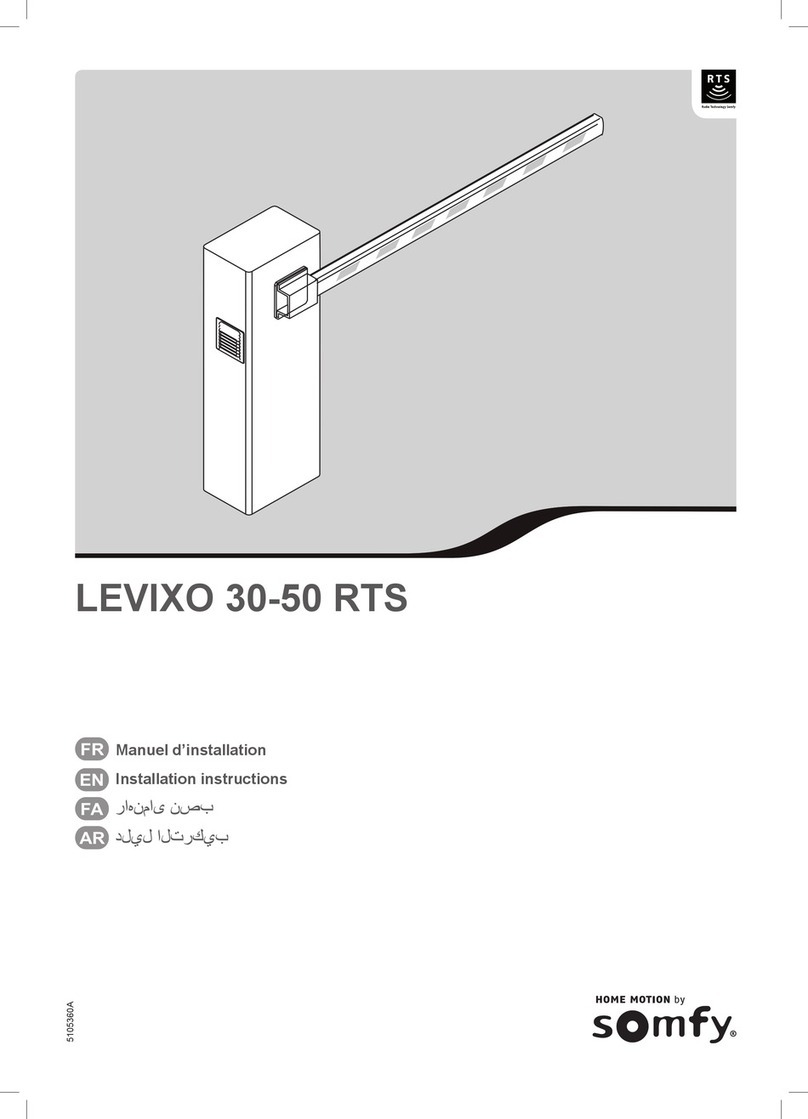
SOMFY
SOMFY Home Motion LEVIXO 30 RTS installation instructions
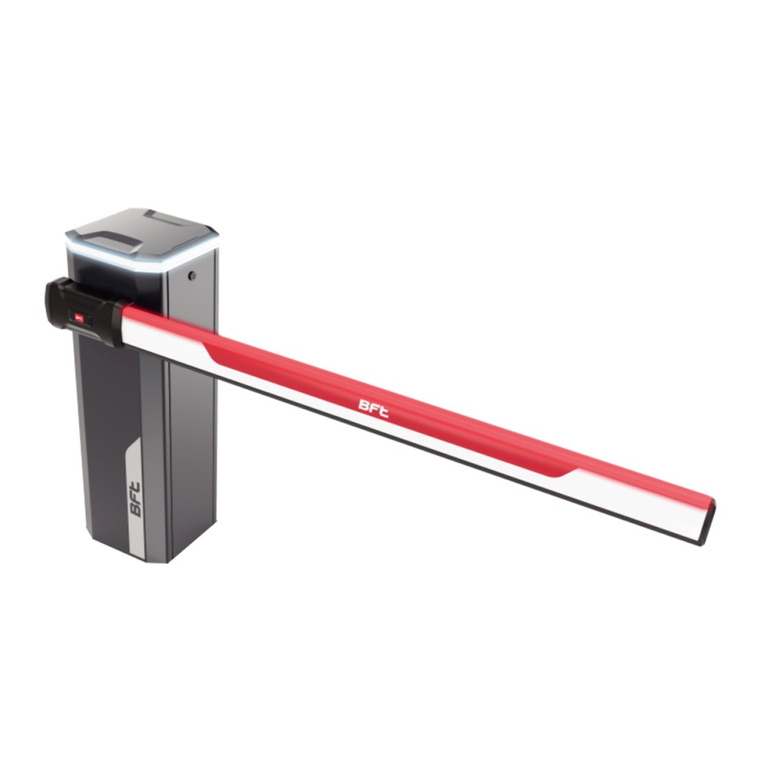
BFT
BFT Maxima Ultra 36 Instructions for installation, use and maintenance

DoorKing
DoorKing 1620 Series installation manual

BFT
BFT ESPAS10 COIN Installation and user manual
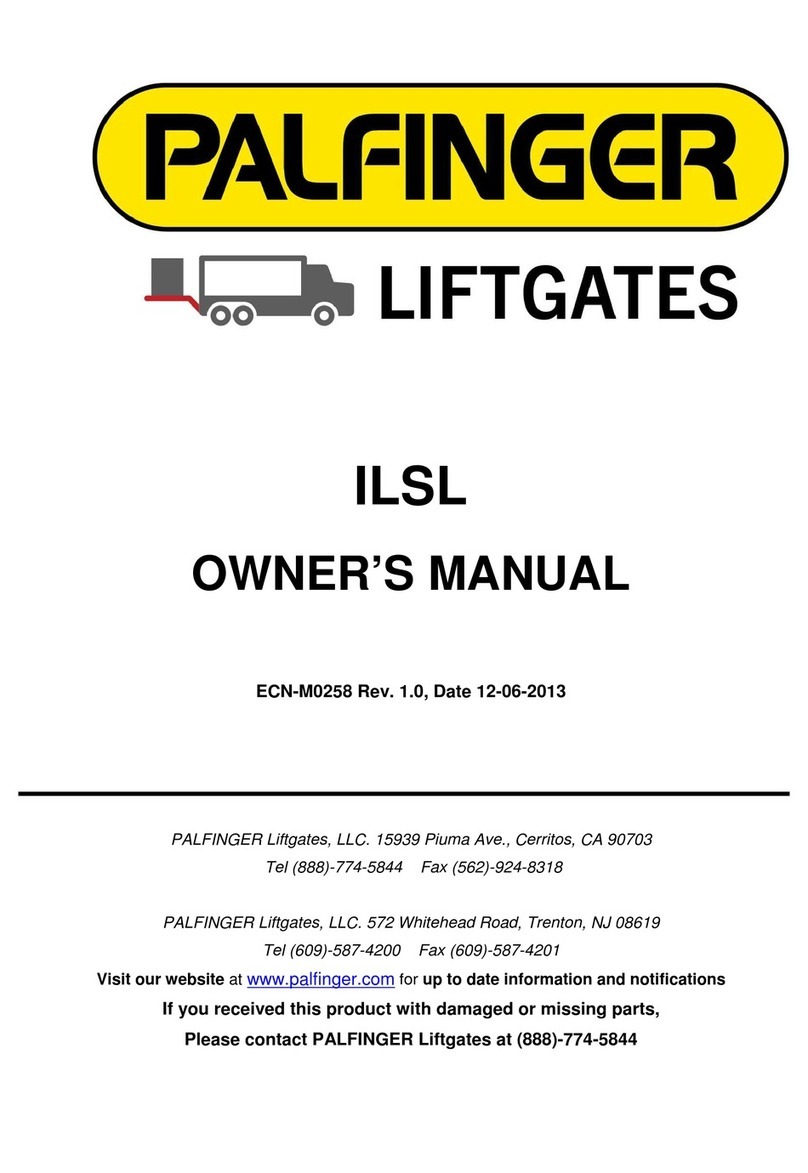
Palfinger
Palfinger ILSL 30 owner's manual
